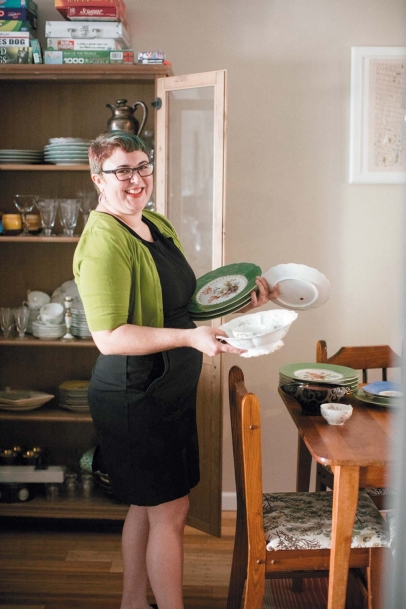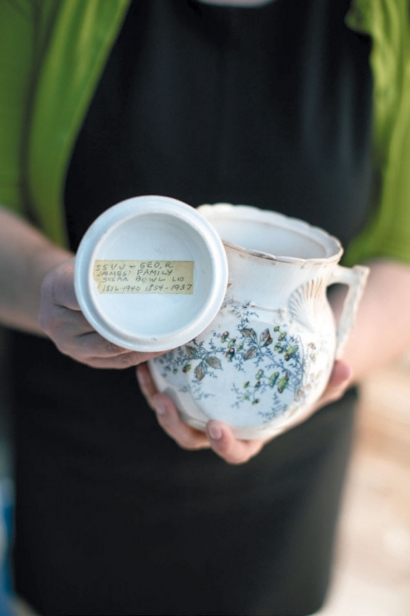One Woman's Reasons for Using, Not Storing, Heirloom Dishes
Setting the Table with Heirloom Pieces
I am thirty-six, and I have a china cabinet now. This isn’t something I ever expected to own, let alone fill. But life has a way of bringing us what we need.
Through the years, I’ve known many homes where the “good china” only came out for holidays, if at all—and God help anyone who drops a saucer—but now that some beautiful china has found its way into my hands, I have no intention of letting it gather dust.
Most belonged once to my grandmother, who gave it to her children; my uncle Gene sent me a box of heirloom china and silver when he moved to a smaller house, and my father and stepmother sent another box after cleaning out their storage unit. Not long after setting up my china cabinet, I won two beautiful contemporary pieces in a raffle at my daughter’s summer camp. All of it is treasure.
I use the good china because it takes up space—unused it would be dead porcelain, a commodity to be stored, too precious to sell but too expensive to risk using.
I use the good china because I remember my family’s lean years not so long ago, the years of 99-cent pizza and catastrophic allergies and roaches in the kitchen. Back then we ate from paper plates, and more than once the gas company, called in to check out a smell in the kitchen, found the gas line gnawed by mice. The landlord refused to call an exterminator. There was no such thing as relaxing in the kitchen in those days.
I use the good china because I love the sound the cup makes when I set it, full of coffee, in its saucer.
I use the good china because I refuse to look at guests with a cold eye and try to calculate who’s important enough. If you’re too old for the plastic Elmo plates, you’re good enough for the good china. No one has broken any yet—not even a kindergartner eager to set the table all by herself.
I use the good china because my grandmother used it, celebrated with it, tried her hardest as a hapless young bride with a World War II ration book in hand to create dinners that would please the handsome pilot she’d married. “That was a fine effort,” he told her lovingly on the first night home from their honeymoon. She never did get the hang of cooking—even in her seventies, she was notorious for explaining that her toaster was broken and offering to microwave some bread—but she entertained every guest with style and grace.
I use the good china because she loved china patterns and dinner parties and Emily Post’s table-setting diagrams—and also because those parties have faded from her memory; because now, with Alzheimer’s, she is spoon-fed by nurses, and perhaps one day I too will no longer remember the meals that graced these plates.
I use the good china because everyone wants to know where it came from, and before long we’re talking about long-ago families and forward-thinking artists and meals whose flavors we’ll never forget.
I use the good china because some of it, before it came to me, sat for years in a carefully packed box in a storage unit, untouched by sauces or forks.
I use the good china because I have the gene that drives people to let things pile up and rot around them, to pick their way through crusted plates and piles of trash. I have seen this happen to my grandmother and my aunts. It trapped them, cutting them off from companionship and even from safety. I intend to be more than what lurks in my genetic code. When I’m anxious and stressed, the state of the house reflects my state of mind; hosting guests and feeding friends forces me to stay one step ahead of the mess.
I use the good china because it asks me to live up to it: to handle it with tenderness, to clean it and care for it, to serve meals worthy of it, to remember the hands that for seventy years have placed it on table after table, napkins on the right.
I use the good china because some of it is made right here in Kensington by the hands of a mother whose children make art with mine. I want my daughter to know that art is valuable and meaningful and that she can, if she chooses, make beautiful and useful things with her hands for a living. I want her to know that there is honor in mastering a craft.
I use the good china because a friendly Virginia woman I’ve still never met once spotted my grandmother’s plates in a photo I posted on Facebook of one of my dinner parties, tracked down the pattern, and mailed me a set of plates to match them—just because she liked the idea that we would use them for pasta and candlelight and laughter. We do, most weeks. Later, out of sheer kindness, she mailed me a dozen dessert plates, too, in a rainbow of colors and with the same impossibly detailed 1940s floral pattern painted in the middle. We used them to ring in the New Year with poached pears and zabaglione.
I use the good china because I want its ornate patterns and delicate heft to shape my daughter’s imagination—to lift her gaze from chicken fingers and peanut butter crackers to rest on something older and richer and deeper in which she has a part to play.
I use the good china because the world is huge and full of pain and loss; if a plate cracks or a teacup shatters, no one is harmed. What’s the point of life if the good stuff always stays locked away, safe and forbidden? When something beautiful finds its way to you, you must incorporate its beauty into your life, even if that means you risk losing it.







